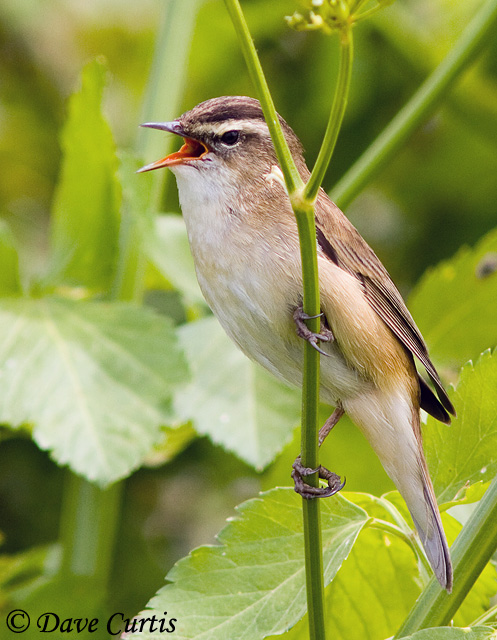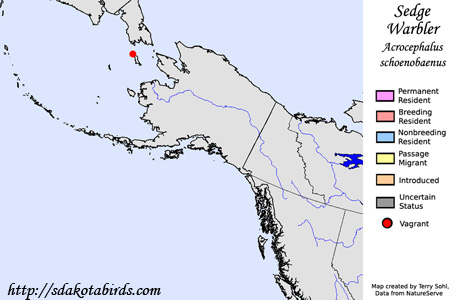| Length: 5.25 inches | Wingspan: 7.5 inches | Seasonality: Non-resident in South Dakota |
| ID Keys: Brown above with dark streaks, creamy white below, white supercillium, | ||
 The
Sedge Warbler is a small passerine with a breeding range that covers much of
Europe and western Asia. They are strongly migratory, with migrating
birds flying over the vast Sahara desert on their way to wintering grounds
in central and southern Africa. In North America, they are only known from a
single sighting, on Gambell Island in the Bering Sea, in 2007. Their
normal breeding grounds are quite a distance from the location of the North
American sighting, and normal migration patterns would take Sedge Warblers
far away from North America. Numbers of Sedge Warblers have declined
in recent decades, as their preferred wetland habitats have been lost.
The
Sedge Warbler is a small passerine with a breeding range that covers much of
Europe and western Asia. They are strongly migratory, with migrating
birds flying over the vast Sahara desert on their way to wintering grounds
in central and southern Africa. In North America, they are only known from a
single sighting, on Gambell Island in the Bering Sea, in 2007. Their
normal breeding grounds are quite a distance from the location of the North
American sighting, and normal migration patterns would take Sedge Warblers
far away from North America. Numbers of Sedge Warblers have declined
in recent decades, as their preferred wetland habitats have been lost.
Habitat: Found in and around wetlands with significant herbaceous wetland vegetation. Will occasionally breed in other habitats, but always with wetland habitats in close proximity.
Diet: Feeds on insects and spiders. During the winter months, may also feed on berries.
Behavior: Feeds in thick wetland vegetation, or in nearby habitats. Foraging techniques include gleaning insects from the vegetation foliage, either while clambering through vegetation, or while hovering. They will also sometimes capture flying insects in mid-air.
Nesting: The female builds a small, cup-shaped nest of grasses, weed stems, leaves, and spider webs. The nest is placed on the ground, or quite low in vegetation. The female lays between 3 and 5 eggs, and she alone incubates them. After the eggs hatch, both parents help tend to and feed the young, who leave the nest after about 2 weeks.
Song: Song is a long, variable, rapid series of phrases. Even the same individual will vary phrases in a song, often interspersing imitations of songs from other species.
Migration: Breeds throughout much of Europe and the western half of Asia. Winters in Africa.
Interactive eBird Map: Click here to access an interactive eBird map of Sedge Warbler sightings
Similar Species: Similar to other species in the "Reed Warbler" family of the Old World, a group unlikely to be found in North America.
Conservation Status: While populations may be decreasing, Sedge Warblers are found over a wide geographic area and are common in many locations. The IUCN lists the Sedge Warbler as a species of "Least Concern".
Further Information: 1) Royal Society for the Protection of Birds - Sedge Warbler
2) Whatbird - Sedge Warbler
3) Arkive - Sedge Warbler
Photo Information: Photo taken by Dave Curtis - May 5th, 2011 - Blakeney, England, Great Britain - Photo licensed under Creative Commons Attribution NonCommercial NoDerivs 2.0 Generic License.
| Click below for a higher-resolution map |
 |
| South Dakota Status: Non-resident in South Dakota |
Additional Sedge Warbler Photos (coming soon!!)
